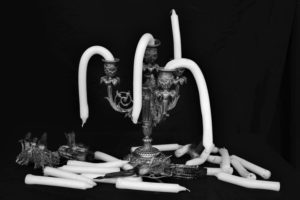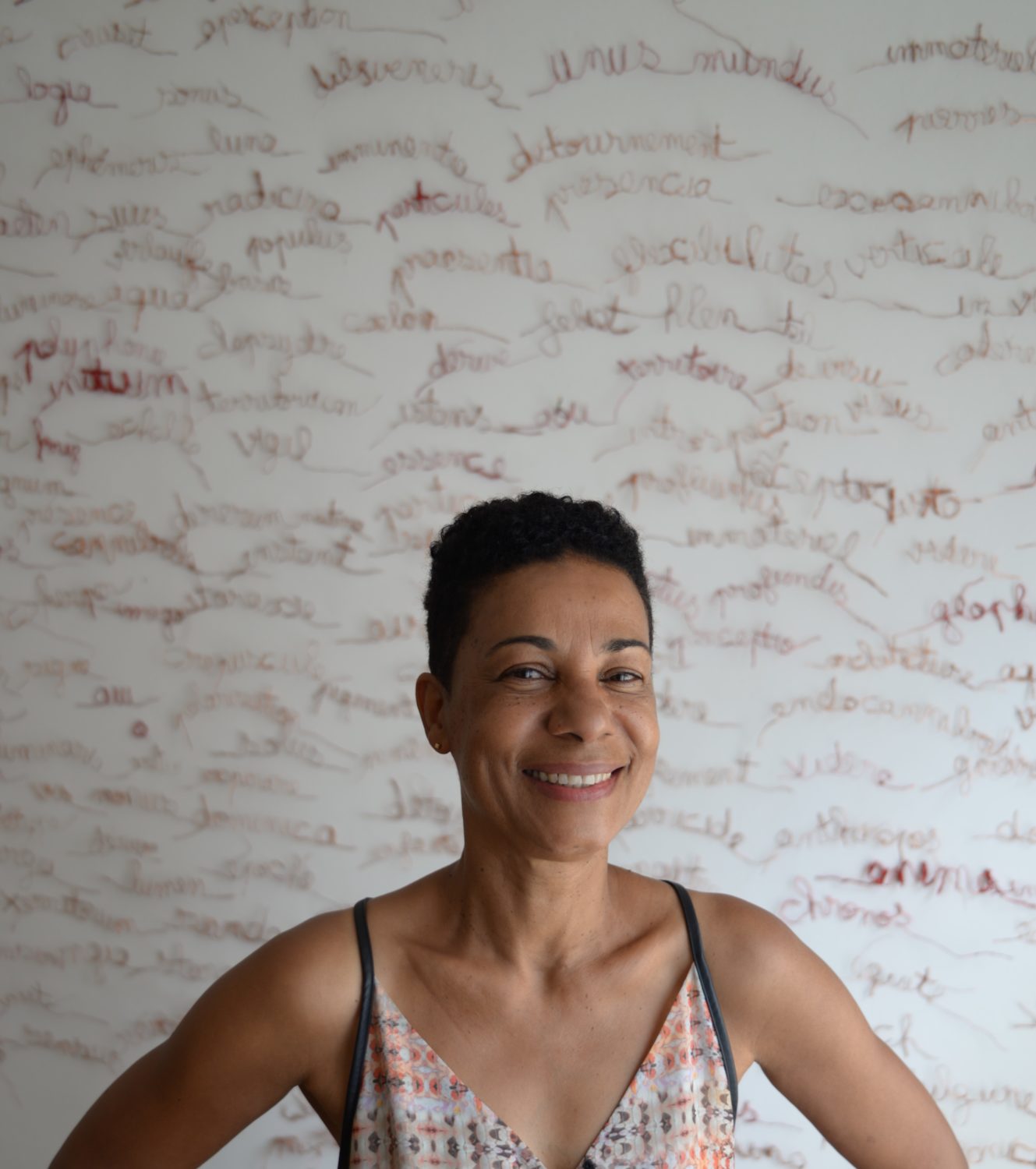Prix AWARE
© Photo: Ronald Staub

Myriam Mihindou, Visage, from the serie La Langue secouée, 2018, copper, carbon, 40 x 30 cm, Courtesy Myriam Mihindou & Galerie Maïa Muller, © ADAGP, Paris

Myriam Mihindou, Nature morte au chandelier, 2016, Fine Art print, 60 x 90 cm, Courtesy Myriam Mihindou & Galerie Maïa Muller, © ADAGP, Paris
Myriam Mihindou is a French-Gabonese artist, trained at the École supérieure des beaux-arts in Bordeaux in the early 1990s, but also through a seismic wave of seas and continents (Morocco, Réunion, Egypt) from which she received a kind of intercultural acupuncture of time and space. Her practice takes the form of a living corpus: it is of and about her artist’s body, “this social and political chrysalis”, in dialogue with the word, through the mediational use of therapeutic materials. In this reciprocal choreography of performance, language and sculpture, inhabited by the energetic memory of the different media chosen – the comfort of cotton, the transparency of glass and of threads of silk – a plastic apparatus taking the form of a ‘sacred pharmacy’ is deployed more widely in the work of Myriam Mihindou, serving a common cause: retaking, repairing, reinfusing society with the ‘lifeblood’ of the ‘aliquid boni’ (‘something good’).

Myriam Mihindou, La Curée/The Kill, 2017, performance, Palazzo Rossini Pavillon Art & Globalization, Biennale de Venise 2017, Courtesy Myriam Mihindou & Galerie Maïa Muller, © ADAGP, Paris
Sculptor of the immaterial, she engages with both the photographic image, which she often treats as a ‘negative’ (Découcha’j, 2004-2006), and ephemeral mediums – those that bodies dissolve or of which often only the imprint remains: wax, cotton, Fleurs de peau soaps (2019) which become bones-reliquaries of life in relation to the body of the artist – that we must constantly watch in order to awaken. Her taste for organic materials which ‘evanesce’ – situated in an ‘infrathin’ suspended between the visible and the invisible which alone ‘assonates’ with the deep memory of the body – leads to the kingdom of the “sacred feminine”, dominated by her pantheon of nine cotton she-wolves, suspended or placed on the ground, like the last she-wolf: La Lopa-Myrte-silk thread-etymologies-hemp-cotton flowers-feather (2015-2016). In communication with these founding pythia, another genesis is prepared on the original ground of feminine power (‘femininitude’): the series Langues secouées, an attempted bodily appropriation of etymology. Divided between two languages and numerous mingled waters carrying other idioms, since 2006 Myriam Mihindou has devoted a large part of her practice – at the crossroads of social memories and collective unconscious – to the exploration of the loss and the reconquest of the French language, of which she is an expert – “illiterate” – “unruly”.

Myriam Mihindou, Déchoucaj’19, 2004-2006, silver print laminated on steel, 90 x 60 cm, Courtesy Myriam Mihindou & Galerie Maïa Muller, © ADAGP, Paris
This series also more broadly situates the colonial and contemporary experience of the failure of language as a tool for communication or vehicle of affects, to the “benefit” of a space of uncommunication and violence where “words have stained [our memory]”, instead of stratifying it. Conversely, or simultaneously, (bringing together opposite concepts is Myriam Mihindou’s ‘modus operandi’) her work consists of putting in place strategies of emancipation through jolts; freeing words from their shackles through the sound or the dull softness of cotton. These cocoons of words, these bouquets of genealogies from French language dictionaries: Myriam Mihindou unmasks them, conceals or “un-assimilates” them for our gaze, encouraging us to engage in a paradoxical reading between the closing down or expansion of words, in order to create the “ayendoété”, this “untranslatable” yipunu which for the artist stands for the possibility to create for her community, for the “vitality to say and to transmit that which [you] have been taught”.
The langues secouées express the intimate upheavals of this dislocation, transcended by the harmonisation of antagonistic founding forces: those which lead to separation, to claudication, that is if they do not become psalms through the discipline of the body as joint power created by pleasure and pain, to which Mihindou daily bends herself, plante pliante polygame. In her in-body-performances, assuming the fumbling of Folle (2004), wielding a feather or a leaf – “up-rooted” antidotes and antibodies – she polarises anachronistic vibration: from the “molochian” impulses of disunity, she draws forces from Transmissions (2018), these canes-poles of power, which have become, in ceramic, vine-crutches of knowledge, fragile and unbreakable.
This is how Myriam Mihindou, far from pinning down word-‘butterflies’ entrusts us with a word as an example, in order that we may “maintain it”. What reveals itself, then, more widely, in this work of communion between individual and collective resonances of words and bodies, are the contours of a possible incarnation of knowledge – “reclaiming the word for oneself.” There, the reminiscences in transhumance animate the wave-foam, the percept blows in the precept: the walking words activate this awakened language which now “writes itself by itself” and “opens the border”.
Alicia Knock
Myriam Mihindou was born in 1964 in Libreville, Gabon. As Youana Ouali writes, this French-Gabonese artist “bases her artistic experimentation on the notion of limits. A nomad, she appropriates spaces, embodies them, presents to our view states of transition; initiatory, cathartic. The question of the body is then related to memory, to identity, and to territory. A ‘trans-emotional’ production, integrating a political dimension, the body of work takes us beyond tangible limits.”
Her work has been presented in numerous personal exhibitions in France, notably at the Pablo-Picasso – La Guerre et la Paix at Vallauris (2018) and at the galerie Maïa Muller in Paris (2020), as well as abroad. Moreover, she has participated in many collective exhibitions: at the National Museum of African Art of the Smithsonian Institution in Washington (2014), at the MAC VAL – musée d’art contemporain du Val-de-Marne in Vitry-sur-Seine (2015), at the Halle Saint-Pierre in Paris (2016), at the l’Institut d’art contemporain in Villeurbanne (2016), at the musée d’Art contemporain de la Haute-Vienne in Rochechouart (2016), at the CCCOD – centre de création contemporaine Olivier-Debré in Tours (2019), and at the musée du quai Branly – Jacques-Chirac in Paris (2021), to name only a few. Her last personal exhibition, Silo, took place at the Transpalette de Bourges in 2021. Her most recent performances have been shown at the musée national d’art moderne – Centre Georges-Pompidou (2019), at the musée de la Chasse in Paris (2021), at the FRAC Nouvelle-Aquitaine Méca in Bordeaux (2021), and at the CAPC in Bordeaux (2021).
Translated from French by Eléonore Besse.
Tous droits réservés dans tous pays/All rights reserved for all countries.





